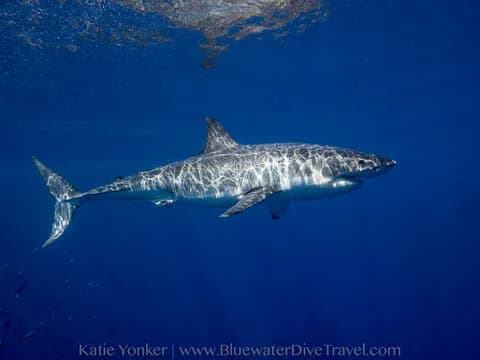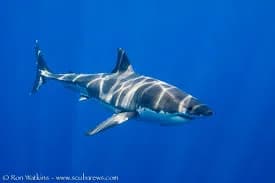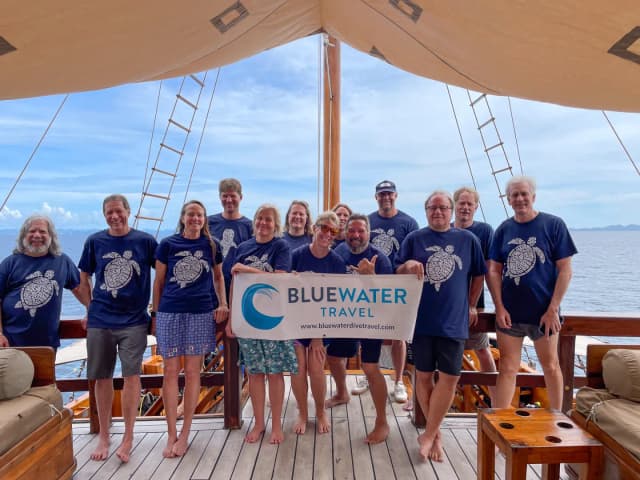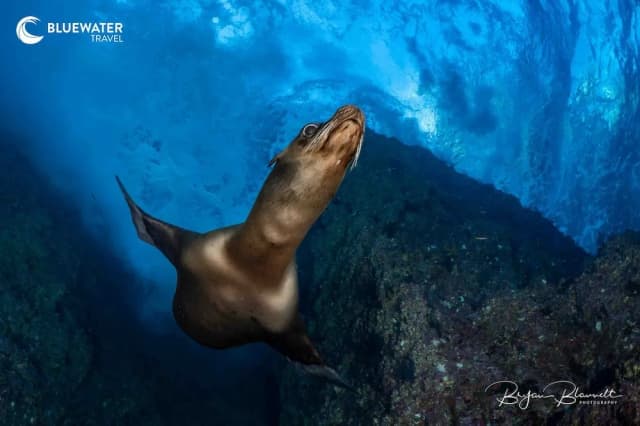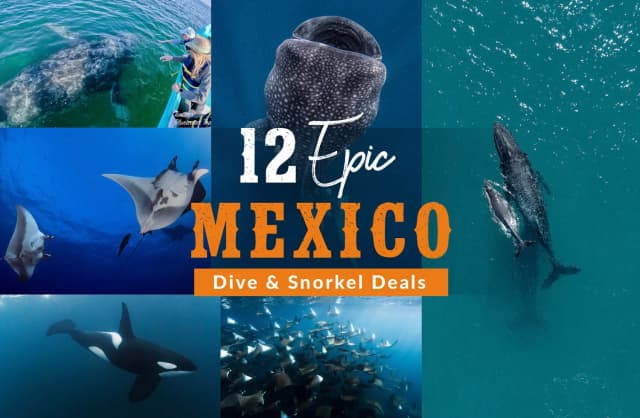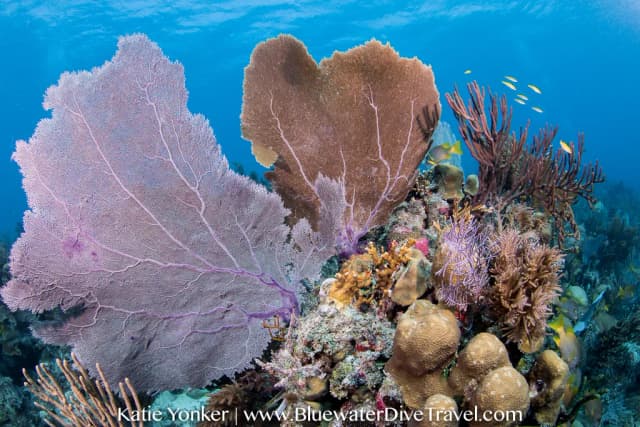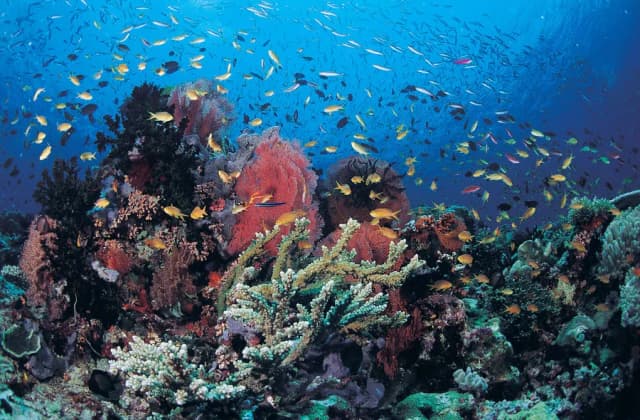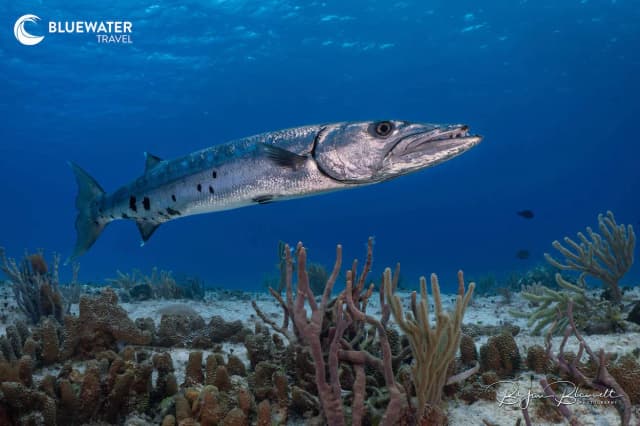Guadalupe and Her Sharks: A Conservation Success Story
Bluewater Travel has long been an advocate of underwater conservation, and we understand only too well the value of a rich and diverse marine ecosystem. Many of our most memorable dive trips have been as a result of awesome encounters with iconic marine creatures, experiencing a brief but intimate snapshot of their world that will stay with our guests for a lifetime.
Bluewater Travel Adviser and Trip Leader, Katie Yonker, has dived with sharks on many of her trips, and cant wait for the next opportunity. Swimming among sharks in their natural habitat is a truly humbling experience. When you get to witness how calm and cautious these animals are, it dispels all myths of these creatures being ferocious man-eaters.
Shark Tourism
Sharks, in particular, stand to benefit from this type of non-invasive wildlife tourism. Their commercial value has led to the widespread and wasteful hunting of many shark species close to extinction, and where the one-off value of a slaughtered shark provides short-term gains for a single fisherman, a living shark encountered by numerous divers over many years holds immeasurable value.
Thats why, at Bluewater Travel, we advocate dive travel as an effective means of conservation and support measures that protect species and preserve their habitats for future generations of divers to enjoy.
In a bid to promote the plight of the worlds sharks, weve teamed up with Los Angeles-based shark conservation group, Shark Allies. Dedicated to the protection and conservation of sharks and rays, Shark Allies focuses on raising awareness and guiding initiatives that reduce the destructive overfishing of sharks around the globe. Their Sharks Alive campaign highlights shark tourism as a key measure in promoting the value of sharks as an attraction rather than a commodity. And what better place to take part in this initiative than at the worlds premier great white destination, Guadalupe.
Great Whites At Guadalupe
With this years Guadalupe great white season approaching, there has never been a better time to experience these magnificent creatures in one of their most important global habitats. The opportunity to cage dive with Guadalupes great whites is open to divers and non-divers alike, and the experience is life-changing. However, to appreciate the significance of great whites in Guadalupe, one must first understand the islands turbulent ecological past and the interwoven connections of its unique flora and fauna.
The first mention of Guadalupe in official records was made by US and Russian fur seal traders in the 1700s. They would visit the island and hunt the endemic Guadalupe fur seal and local populations of northern elephant seals mercilessly over the next 200 years, driving populations to the brink of extinction. Throughout the 1800s, a turbulent political climate in mainland Mexico resulted in little administrative control over Guadalupe, and the islands were bought and sold in a series of shady private deals that resulted in the formation of the Guadalupe Island Company in 1870.
Importing goats and sheep for their wool and meat, and harvesting white pine and cedar, the Guadalupe Island Company wreaked havoc with Guadalupes numerous endemic plant and animal species. This was a natural disaster for the island, with as many as 30,000 feral goats destroying bird nests and vegetation, and persistent logging drastically altering the unique and fragile habitat. In the space of five years, a biologically valuable island with 6,000 acres of cloud forest and endemic vegetation was reduced to the stark, arid rock as it appears today.
Guadalupe was finally returned to Mexican control in 1885. Realizing the fate of the Guadalupe fur seal was close to that of other extinct local taxa, in 1894 Mexico placed an armed caretaker at Point Norte. This was the first conservation measure taken by the Mexican government at Guadalupe, however, it wasnt until 1975 that the island was declared a Pinniped Sanctuary in an effort to protect the seal populations. Finally, in 2008, the Mexican government, along with various NGOs, began an eradication campaign to remove goats and sheep from the island for good.
Conserving Guadalupe
You may be wondering what all this has to do with great white sharks, but in fact, the answer is everything. Guadalupe Island is the premier destination in the world to cage dive with great whites. From August through to October each year, dozens of sharks congregate in Guadalupes waters to feed on fur seals and search for a mate. Experiencing these apex predators in their optimum environment is life-changing, and not for the faint-hearted! Individuals as big as 19ft glide silently between the dive boats, and the young frisky males can be quite boisterous as they crowd the cages.
Researching and conserving this apex predator is essential not only for the health of Guadalupes marine ecosystem but serves to raise awareness of the plight of Guadalupe Island. The numerous eco-tourism businesses that rely on the living value of the great whites also promote the conservation of the island and its many damaged habitats. Furthermore, the divers that jostle for a limited spot on one of the Guadalupe liveaboards are the very individuals advocating the preservation of sharks through shark tourism.
In 2000, the very first Guadalupe shark cage dive heralded a new era in the conservation of the island, and in the following 20 years scientific vessels and liveaboards have carried out much research into great white shark numbers. Boats such as the Socorro Vortex and the Solmar V take an active role in monitoring the behavior of sharks as well as facilitating safe access for divers and non-divers to experience them first hand. Now a Biosphere Reserve, Guadalupes remaining endemic species, and the presence of a key oceanic predator have placed the island firmly at the forefront of global conservation efforts. White shark research, tagging, and tracking, alongside island regeneration projects, have brought numerous government bodies, NGOs, and eco-tourism organizations together to protect and preserve this fascinating island.
If you would like to find out more about research and diving at Guadalupe, get in touch with Bluewater Travel to book your trip and experience great white sharks in the best location for shark cage diving in the world.
And for those of you unable to dive or travel at the moment, you can find out more about the important work carried out by Shark Allies, and take action to support their latest campaigns.
